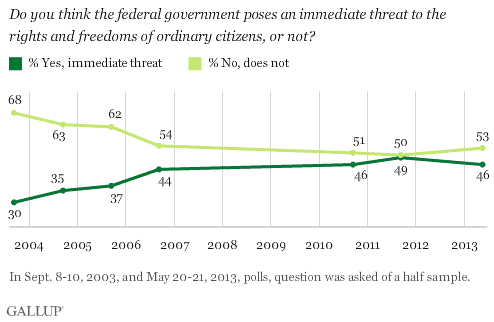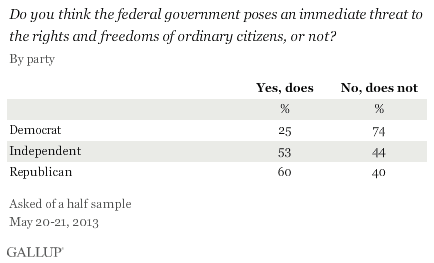PRINCETON, NJ -- Fifty-four percent of Americans say the federal government today has too much power. Despite the recent controversies facing federal agencies such as the IRS, these views are only marginally higher than in 2012, and slightly lower than in 2010 and 2011. At least half of Americans since 2005 have said the federal government has too much power, whereas in the three years prior to that, Americans were more inclined to believe federal power was "about right."
![Trend: Do you think the federal government today -- [ROTATED: has too much power, has about the right amount of power, or has too little power]?](http://content.gallup.com/origin/gallupinc/GallupSpaces/Production/Cms/POLL/nn7uful2b0y4f8k39gvuea.gif)
Americans' views of federal power have become a renewed focal point in recent weeks with allegations that the IRS used its power to selectively audit certain types of organizations, and news reports of Justice Department investigations into Associated Press and Fox News records and emails. It does not appear, however, that these news stories have dramatically altered Americans' views of the federal government's power. The 54% who now say the federal government has "too much power" is in the same general range as it has been since 2005.
Only 8% of Americans say the federal government has "too little" power, while 36% say the government has about the right amount of power.
As would be expected, there is a major gulf between Republicans' and Democrats' views on this issue. More than twice as many Republicans (76%) as Democrats (32%) say the government has too much power, with a majority of independents coming down on the same side as Republicans.
![Do you think the federal government today -- [ROTATED: has too much power, has about the right amount of power, or has too little power]? By party, May 2013](http://content.gallup.com/origin/gallupinc/GallupSpaces/Production/Cms/POLL/qsgo6tbbmk2jq3zwolqcka.gif)
Americans' Views on Federal Government "Threat" Remain Steady
Just under half of Americans -- 46% -- agree with the contention that the federal government "poses an immediate threat to the rights and freedoms of ordinary citizens," while 53% disagree. The percentage of Americans who agree with this strongly worded statement is actually no higher than it was in 2010 (46%) or 2011 (49%), when the question was last asked.

As was the case with the general federal power assessment, these attitudes were less severe earlier in the last decade, with 30% agreeing in September 2003.
Republicans are much more likely than Democrats to agree with this assertion about the threat of government power, although a quarter of Democrats say they agree.

A follow-up question asked in 2010 showed that Americans who agreed with this statement were most likely to explain their position by talking about the government's having too many laws, being too involved in citizens' lives, threatening freedom of speech, imposing healthcare laws, and being "socialist" in general. This follow-up question was not asked in the current poll, so it is not known if the 46% who currently say the government constitutes an immediate threat justify that position with these same types of thoughts.
Implications
While a majority of Americans believe the federal government has too much power, and 46% say the federal government poses an immediate threat to ordinary citizens, these views have not changed significantly over the last year or two. The relative stability of these measures suggests that the current news focused on allegations of misuse of government power has not had an immediate impact on the public's views of the federal government, at least as measured by these two questions. At the same time, an update on Americans' views of the IRS shows significantly more negative attitudes now than in 2009, underscoring the idea that the current scandals' impact may be more localized to specific agencies rather than generalized to the entire federal government.
Survey Methods
Results for this Gallup poll are based on telephone interviews conducted May 20-21, 2013, on the Gallup Daily tracking survey, with a random sample of 1,016 adults, aged 18 and older, living in all 50 U.S. states and the District of Columbia.
For results based on the total sample of national adults, one can say with 95% confidence that the margin of sampling error is ±4 percentage points.
For results based on the sample of 524 national adults in Form A, one can say with 95% confidence that the margin of sampling error is ±6 percentage points.
Interviews are conducted with respondents on landline telephones and cellular phones, with interviews conducted in Spanish for respondents who are primarily Spanish-speaking. Each sample of national adults includes a minimum quota of 50% cellphone respondents and 50% landline respondents, with additional minimum quotas by region. Landline telephone numbers are chosen at random among listed telephone numbers. Cellphone numbers are selected using random digit dial methods. Landline respondents are chosen at random within each household on the basis of which member had the most recent birthday.
Samples are weighted to correct for unequal selection probability, nonresponse, and double coverage of landline and cell users in the two sampling frames. They are also weighted to match the national demographics of gender, age, race, Hispanic ethnicity, education, region, population density, and phone status (cellphone only/landline only/both, cellphone mostly, and having an unlisted landline number). Demographic weighting targets are based on the March 2012 Current Population Survey figures for the aged 18 and older U.S. population. Phone status targets are based on the July-December 2011 National Health Interview Survey. Population density targets are based on the 2010 census. All reported margins of sampling error include the computed design effects for weighting.
In addition to sampling error, question wording and practical difficulties in conducting surveys can introduce error or bias into the findings of public opinion polls.
View methodology, full question results, and trend data.
For more details on Gallup's polling methodology, visit www.gallup.com.